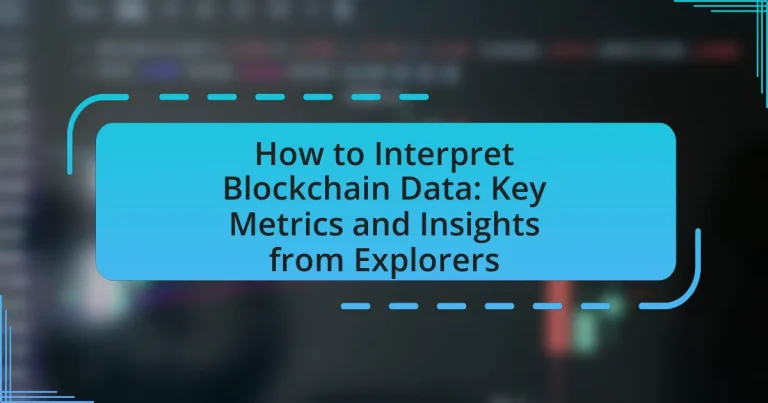Blockchain data interpretation involves analyzing and understanding the information stored on a blockchain, including transaction records and network statistics. This process is essential for stakeholders to make informed decisions and enhance transparency in decentralized systems. Blockchain explorers play a crucial role by providing user-friendly interfaces that display transaction details and network metrics, facilitating data analysis. Key metrics such as transaction volume, fees, block size, hash rate, and active addresses are vital for assessing blockchain performance and user engagement. The article will explore how to effectively interpret blockchain data, the insights gained from explorers, and best practices for accurate analysis.
What is Blockchain Data Interpretation?
Blockchain data interpretation is the process of analyzing and understanding the information stored on a blockchain. This involves examining transaction records, block details, and network statistics to derive insights about user behavior, transaction trends, and overall network health. Accurate interpretation is crucial for stakeholders, as it enables informed decision-making and enhances transparency in decentralized systems.
How do blockchain explorers facilitate data interpretation?
Blockchain explorers facilitate data interpretation by providing user-friendly interfaces that display transaction details, block information, and network statistics in an accessible format. These tools allow users to easily search for specific transactions, view wallet balances, and analyze blockchain activity over time. For instance, explorers like Etherscan and Blockchair present data such as transaction hashes, timestamps, and block confirmations, enabling users to track the flow of assets and verify the integrity of transactions. This transparency and accessibility of information enhance users’ understanding of blockchain dynamics and support informed decision-making.
What are the key features of blockchain explorers?
Blockchain explorers provide essential features for users to analyze and interact with blockchain data. Key features include transaction tracking, which allows users to view details of specific transactions, including sender and receiver addresses, transaction amounts, and timestamps. Another feature is block exploration, enabling users to access information about individual blocks, such as block height, miner details, and the number of transactions included. Additionally, blockchain explorers offer address lookup, allowing users to check the balance and transaction history of specific wallet addresses. They also provide network statistics, which present real-time data on network performance, including hash rate and transaction volume. These features collectively enhance user understanding and navigation of blockchain ecosystems.
How do users interact with blockchain explorers?
Users interact with blockchain explorers by searching for specific transactions, addresses, or blocks to obtain detailed information about blockchain activity. They utilize the search functionality to input transaction IDs or wallet addresses, which then displays data such as transaction history, confirmation status, and associated fees. Additionally, users can explore block details, including timestamps and miner information, to gain insights into network performance. This interaction is facilitated by the user-friendly interface of blockchain explorers, which presents complex blockchain data in an accessible format, allowing users to track and verify transactions efficiently.
Why is interpreting blockchain data important?
Interpreting blockchain data is important because it enables stakeholders to understand transaction patterns, network health, and user behavior. This understanding is crucial for making informed decisions regarding investments, security measures, and regulatory compliance. For instance, analyzing transaction volumes and wallet activity can reveal trends that inform market strategies, while monitoring network congestion helps in optimizing performance and scalability. Additionally, accurate interpretation of blockchain data can prevent fraud and enhance transparency, as evidenced by the increasing use of blockchain analytics tools in compliance with anti-money laundering regulations.
What insights can be gained from blockchain data?
Blockchain data provides insights into transaction patterns, network activity, and user behavior. By analyzing transaction volumes, one can identify trends in market demand and liquidity. Additionally, metrics such as wallet balances and transaction fees reveal user engagement and the economic health of the blockchain ecosystem. For instance, a spike in transaction fees may indicate increased demand for block space, while a growing number of active addresses can signal rising user adoption. These insights are crucial for investors, developers, and researchers aiming to understand the dynamics of blockchain networks.
How does blockchain data interpretation impact decision-making?
Blockchain data interpretation significantly enhances decision-making by providing transparent, immutable, and real-time insights into transactions and network activities. This clarity allows organizations to analyze patterns, assess risks, and make informed choices based on accurate data. For instance, companies can utilize blockchain analytics tools to track supply chain movements, ensuring product authenticity and reducing fraud, which directly influences operational strategies and resource allocation. Furthermore, studies have shown that businesses leveraging blockchain data for decision-making experience improved efficiency and reduced costs, as evidenced by a report from Deloitte indicating that 40% of organizations using blockchain technology reported enhanced operational efficiency.
What are the Key Metrics in Blockchain Data?
Key metrics in blockchain data include transaction volume, transaction fees, block size, hash rate, and active addresses. Transaction volume measures the number of transactions processed over a specific period, indicating network activity. Transaction fees represent the cost users pay to have their transactions included in a block, reflecting network demand. Block size indicates the amount of data a block can hold, affecting scalability. Hash rate measures the computational power used to mine blocks, influencing network security and transaction confirmation times. Active addresses represent unique addresses that have participated in transactions, providing insight into user engagement and network growth. These metrics are essential for analyzing blockchain performance and user behavior.
Which metrics are essential for analyzing blockchain data?
Essential metrics for analyzing blockchain data include transaction volume, transaction fees, block size, hash rate, and active addresses. Transaction volume indicates the number of transactions occurring within a specific timeframe, providing insight into network activity. Transaction fees reflect the cost of processing transactions, which can indicate network congestion. Block size measures the amount of data contained in each block, influencing the speed and efficiency of the blockchain. Hash rate represents the computational power used to mine and validate transactions, affecting network security and transaction confirmation times. Active addresses show the number of unique addresses participating in transactions, indicating user engagement and network utilization. These metrics collectively offer a comprehensive view of blockchain performance and health.
What is transaction volume and why does it matter?
Transaction volume refers to the total number of transactions conducted within a specific timeframe on a blockchain network. It matters because it serves as a key indicator of network activity and user engagement, reflecting the overall health and adoption of the blockchain. High transaction volume often correlates with increased interest and utility of the blockchain, while low volume may indicate stagnation or reduced user interest. For instance, Bitcoin’s transaction volume reached over 300,000 transactions per day in 2021, highlighting its widespread use and acceptance.
How do transaction fees influence blockchain activity?
Transaction fees significantly influence blockchain activity by affecting user behavior and network congestion. Higher transaction fees incentivize miners to prioritize certain transactions, leading to faster confirmations for those willing to pay more. Conversely, lower fees can result in delayed processing times, as miners may choose to ignore transactions with insufficient fees. For example, during periods of high demand, such as Bitcoin’s price surges, transaction fees can spike dramatically, causing users to adjust their transaction strategies accordingly. This dynamic creates a direct correlation between fee levels and the volume of transactions processed, as users often opt for higher fees to ensure timely execution.
How can one measure network health through blockchain metrics?
One can measure network health through blockchain metrics by analyzing key indicators such as transaction volume, block time, hash rate, and the number of active addresses. Transaction volume reflects the level of activity on the network, while block time indicates how quickly transactions are being processed. A higher hash rate signifies greater security and network stability, as it represents the computational power securing the blockchain. Additionally, the number of active addresses provides insight into user engagement and network utilization. These metrics collectively offer a comprehensive view of the blockchain’s operational efficiency and overall health.
What is hash rate and how does it affect security?
Hash rate is the measure of computational power used in cryptocurrency mining, indicating how many hashes a miner can compute per second. A higher hash rate enhances security by making it more difficult for malicious actors to execute attacks, such as double-spending or taking control of the network. For example, Bitcoin’s network security relies on a substantial hash rate, as it requires significant computational resources to alter transaction history, thereby deterring potential attacks. In 2023, Bitcoin’s hash rate reached over 300 EH/s (exahashes per second), demonstrating the network’s robust security against threats.
How do active addresses indicate network usage?
Active addresses indicate network usage by reflecting the number of unique participants engaging in transactions on a blockchain. A higher count of active addresses typically signifies increased activity and interest in the network, as it shows more users are sending or receiving assets. For instance, during periods of market volatility or significant events, spikes in active addresses can be observed, demonstrating heightened engagement. This metric serves as a crucial indicator for analysts and investors to gauge the overall health and adoption of a blockchain network.
What Insights Can Be Gained from Blockchain Explorers?
Blockchain explorers provide insights into transaction history, network activity, and wallet balances. By analyzing transaction data, users can track the flow of assets, identify trends in transaction volume, and assess the overall health of a blockchain network. For instance, explorers can reveal the number of active addresses, which indicates user engagement, and the average transaction fees, reflecting network demand. Additionally, they allow for the verification of transaction confirmations, enhancing transparency and trust in the blockchain ecosystem.
How can trends be identified through blockchain data?
Trends can be identified through blockchain data by analyzing transaction patterns, user behavior, and network activity over time. By utilizing blockchain explorers, analysts can track metrics such as transaction volume, wallet addresses, and block times, which provide insights into market sentiment and usage trends. For instance, a significant increase in transaction volume may indicate heightened interest or activity in a particular cryptocurrency, while changes in wallet addresses can reveal shifts in user engagement or investment strategies. These data points allow for the identification of emerging trends, such as the rise of decentralized finance (DeFi) or non-fungible tokens (NFTs), by correlating historical data with current market movements.
What patterns emerge from transaction history analysis?
Transaction history analysis reveals several key patterns, including transaction frequency, transaction volume, and user behavior trends. Transaction frequency indicates how often users engage with the blockchain, while transaction volume reflects the amount of cryptocurrency being transferred, which can signal market activity levels. User behavior trends can highlight patterns such as the timing of transactions, common transaction sizes, and the identification of active wallets. These patterns are essential for understanding market dynamics and can inform investment strategies, as evidenced by studies showing correlations between transaction volume spikes and price movements in cryptocurrencies.
How can one track the movement of assets on the blockchain?
One can track the movement of assets on the blockchain by utilizing blockchain explorers, which are tools that provide real-time data on transactions and asset transfers. These explorers allow users to input wallet addresses or transaction IDs to view detailed information about the movement of assets, including transaction history, timestamps, and the amounts transferred. For example, Bitcoin blockchain explorers like Blockchair or Blockchain.com enable users to see all transactions associated with a specific Bitcoin address, confirming the asset’s movement across the network. This transparency is inherent to blockchain technology, as all transactions are recorded on a public ledger, ensuring that anyone can verify the flow of assets.
What are the common pitfalls in interpreting blockchain data?
Common pitfalls in interpreting blockchain data include misunderstanding the pseudonymous nature of transactions, over-relying on on-chain metrics without considering off-chain factors, and failing to account for the potential for data manipulation. The pseudonymous aspect can lead to incorrect assumptions about user identities and behaviors, as transactions do not directly reveal personal information. Additionally, on-chain metrics such as transaction volume or wallet balances may not accurately reflect real-world activity or sentiment, as they can be influenced by external events or market conditions. Lastly, the possibility of data manipulation, such as wash trading or fake transactions, can distort the perceived health or activity of a blockchain network, leading to misguided conclusions.
How can misinterpretation of metrics lead to poor decisions?
Misinterpretation of metrics can lead to poor decisions by causing stakeholders to draw incorrect conclusions about performance or trends. For instance, if a blockchain analyst misreads transaction volume as a sign of increased user engagement, they may allocate resources to scale operations unnecessarily, resulting in wasted investments. Accurate interpretation is crucial; a study by the Blockchain Research Institute highlights that 70% of blockchain projects fail due to misaligned expectations based on misunderstood data. Thus, relying on flawed metrics can misguide strategic planning and operational execution.
What are the limitations of blockchain explorers in data analysis?
Blockchain explorers have limitations in data analysis primarily due to their inability to provide comprehensive context for transactions. They typically display raw transaction data, such as addresses, amounts, and timestamps, but lack insights into the purpose or intent behind those transactions. Additionally, blockchain explorers may not effectively aggregate data across multiple transactions or wallets, making it challenging to analyze user behavior or trends. Furthermore, they often do not account for off-chain activities or provide real-time analytics, which can hinder a complete understanding of blockchain dynamics. These limitations restrict the depth of analysis that can be performed, as users may miss critical contextual information necessary for informed decision-making.
What best practices should be followed when interpreting blockchain data?
When interpreting blockchain data, it is essential to follow best practices such as ensuring data accuracy, understanding the context of the data, and utilizing reliable tools for analysis. Data accuracy can be verified by cross-referencing multiple blockchain explorers, which helps confirm transaction details and balances. Understanding the context involves recognizing the specific blockchain’s consensus mechanism and transaction types, as these factors influence data interpretation. Utilizing reliable tools, such as analytical software or APIs, enhances the ability to visualize and analyze blockchain data effectively. These practices are supported by the fact that accurate interpretation can lead to better decision-making in areas like investment and security, as evidenced by studies showing that informed analysis reduces risks associated with blockchain transactions.
How can one ensure accuracy in data interpretation?
To ensure accuracy in data interpretation, one must utilize reliable data sources and apply rigorous analytical methods. Reliable data sources, such as reputable blockchain explorers and verified datasets, provide trustworthy information essential for accurate interpretation. Additionally, employing statistical techniques, such as regression analysis or hypothesis testing, helps validate findings and reduces the risk of misinterpretation. Research indicates that using multiple data sources can enhance accuracy; for instance, a study by Zhang et al. (2020) in the Journal of Blockchain Research highlights that cross-referencing data from different blockchain explorers significantly improves the reliability of insights drawn from blockchain data.
What tools can enhance the analysis of blockchain data?
Tools that can enhance the analysis of blockchain data include blockchain explorers, data analytics platforms, and visualization tools. Blockchain explorers like Etherscan and Blockchair allow users to view transaction histories, wallet balances, and smart contract interactions, providing a foundational understanding of blockchain activity. Data analytics platforms such as Chainalysis and CipherTrace offer advanced analytics, enabling users to track illicit activities and assess risk by analyzing transaction patterns. Visualization tools like D3.js and Tableau help in creating graphical representations of blockchain data, making complex information more accessible and interpretable. These tools collectively improve the ability to analyze and derive insights from blockchain data effectively.





